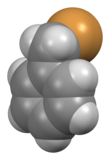| |||
| Names | |||
|---|---|---|---|
| Preferred IUPAC name
(Bromomethyl)benzene | |||
| Other names
α-Bromotoluene
Benzyl bromide | |||
| Identifiers | |||
3D model (JSmol)
|
|||
| ChEBI | |||
| ChEMBL | |||
| ChemSpider | |||
| ECHA InfoCard | 100.002.589 | ||
PubChem CID
|
|||
| UNII | |||
CompTox Dashboard (EPA)
|
|||
| |||
| |||
| Properties | |||
| C7H7Br | |||
| Molar mass | 171.037 g·mol−1 | ||
| Appearance | Colorless liquid | ||
| Odor | Sharp and pungent | ||
| Density | 1.438 g/cm3 | ||
| Melting point | −3.9 °C (25.0 °F; 269.2 K) | ||
| Boiling point | 201 °C (394 °F; 474 K) | ||
| Solubility | organic solvents | ||
| log P | 2.92[2] | ||
Refractive index (nD)
|
1.5752 | ||
| Hazards | |||
| GHS labelling: | |||

| |||
| Flash point | 70 °C (158 °F; 343 K) | ||
Except where otherwise noted, data are given for materials in their standard state (at 25 °C [77 °F], 100 kPa).
| |||
Benzyl bromide is an organic compound with the formula C6H5CH2Br. The molecule consists of a benzene ring substituted with a bromomethyl group. It is a colorless liquid with lachrymatory properties. The compound is a reagent for introducing benzyl groups.[3][4]
- ^ Merck Index (11th ed.). p. 1142.
- ^ "Benzyl bromide_msds".
- ^ William E. Bauta (2001). "Benzyl Bromide". Encyclopedia of Reagents for Organic Synthesis. doi:10.1002/047084289X.rb047. ISBN 0-471-93623-5.
- ^ "Benzyl bromide". Sigma Aldrich. sigmaaldrich.com. Retrieved 8 June 2017.

